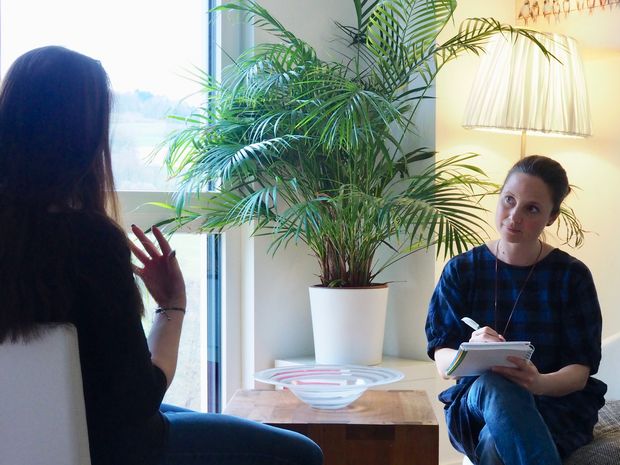Can we reduce our stress levels? Our psychologists say yes, and more often than not, it’s easier than you think.

1. How does relaxation work?
The vegetative nervous system regulates most of our vital bodily functions, including those that we do not voluntarily control, such as circulation, breathing and digestion. The sympathetic and parasympathetic nervous system are like two antagonists and when they interact, they maintain the body’s vegetative balance. The sympathetic nervous system activates our bodies, preparing us for short-term levels of high performance by ensuring a higher heart rate, open airways, and reduced digestive activity. The parasympathetic nervous system, on the other hand, allows us to rest, relax, and replenish our energy reserves. It stimulates our metabolic processes, digestion, and pulse rate as well as decreases our breathing so we can regenerate.
Our current lifestyles mean we are often subject to time pressures, psychological stress factors, and a lack of exercise – all of which can cause our bodies to constantly function at a heightened state.
In order to regenerate and protect the body from long-term debilitation, experts recommend voluntarily and consciously activating the parasympathetic nervous system as often as possible. Even though the parasympathetic nervous system cannot be voluntarily controlled, certain relaxation exercises can have an indirect influence.
2. Selected relaxation practices
There are many ways to get to a relaxing, calmer state. Autogenic training, progressive muscle relaxation, breathing techniques, imaginative and meditative practices, physical exercises, self-hypnosis, yoga, and biofeedback are among the most common and proven methods of relaxation.
Our tip: If a certain relaxation practice does not work for you, don't give up and throw in the towel right away. Try different practices to find out what works best for you.
We would like to take this opportunity to introduce you to a few cognitive relaxation practices and techniques.
Developed in the 1920s by the Berlin psychiatrist J.H. Schultz, autogenic training is based on autosuggestion. By imagining certain sensory perceptions such as heaviness or warmth, you can relax the muscles and improve the body’s circulation. Frequent practice can result in deep states of relaxation, improve the quality of sleep, reduce fears and nervousness as well as pain perception. Today, autogenic training is usually taught in 6 – 8 week group sessions under the guidance of a doctor or psychologist. The Student Psychological Counseling Service Linz expects to offer autogenic training sessions beginning in the fall of 2020.
Our tip: When practicing relaxation techniques, make sure the room is quiet, well-ventilated, and if possible, keep the lighting low. Make sure your body is in a comfortable position and keep a blanket on hand, in case you feel cold.
Meditative methods are rooted in religious practices. These methods were originally intended to enhance spiritual development and deepen one’s self-awareness; not so much for relaxation purposes. Whereas Christian traditions include spiritual exercises, Far Eastern traditions include things like mantras, mindfulness meditations, Zen, but also meditations combined with body movement, such as tai chi, qigong and yoga.
A widespread relaxation practice called Body Scan meditation is enjoying increased popularity. Based on the Buddhist Vipassana tradition, each person mindfully scans the entire body for sensations, consciously perceiving each individual part of the body without trying to fix or change anything. By being an ‘observer in one's own body’, one can possibly distance oneself from stress and pain.
Our tip: Even those who have never really practiced guided relaxation can quickly learn different methods and techniques.
You can find instructions for Body Scan meditation online at:
www.youtube.com/watch?v=j0nMvbvNcog, opens an external URL in a new window
www.youtube.com/watch?v=15q-N-_kkrU, opens an external URL in a new window
Imagination meditation and imaginary journeys are deep-relaxation techniques using positive imagine visualization to help you decompress. This practice - sometimes used as part of a psychotherapy session – makes use of one’s own imagination to help change behaviors to, for example, quit smoking or drinking alcohol, face certain fears, or address depression. In general, imaginative practices can promote a sense of creativity, self-confidence and a general sense of well-being.
Instructions for the "Garten in mir" are available at:
https://youtu.be/0eLYEOKK-fU, opens an external URL in a new window
An invitation to a journey to your strengths (Reise zu Ihren Stärken) is available at:
https://youtu.be/vc_6kymLoKs, opens an external URL in a new window
3. You can’t force yourself to relax
Relaxation exercises can be very effective, especially when done on a regular basis. However, there are times when relaxation exercises are not the right thing at the moment and/or there are also people who feel these kinds of practices are not for them.
Our tip: Listen to what your body is telling you. If you feel uncomfortable, stop the relaxation exercise.
Even if you feel relaxation exercises are not right for you, you can still find ways to relax every day and incorporate relaxation into your routine. Regular exercise, everyday mindfulness, sitting in the sun, and reading positive stories can also be relaxing.
Additional psychological and psychotherapeutic support
If you suffer from anxiety, compulsion, depression, schizophrenia or delusional disorders, or you have been traumatized, we recommend talking with a psychologist before practicing relaxation techniques. You can also contact the Student Psychological Counseling Service Linz by telephone and online.
Call 0732-2468-7930 for appointments for counseling sessions by phone or online.
We are available Monday to Thursday from 7.30 am - 3.30 pm and Friday from 7.30 am - 1.30 pm.








